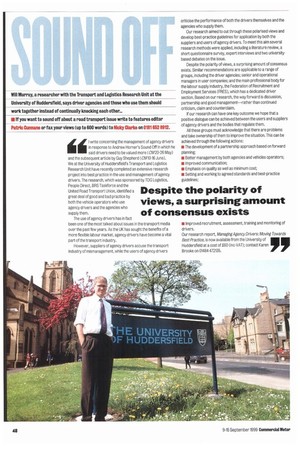Will Murray, a researcher with the Dansport and Logistics Research
Page 50

If you've noticed an error in this article please click here to report it so we can fix it.
Unit at the University of Huddersfield, says driver agencies and those who use them should work together instead of continually knocking each other...
• if you want to sound off about a road transport issue write to features editor Patric Ciimane or fax your views (up to 600 words) to Ricky Parka on 0181852 MM.
ii I write concerning the management of agency drivers
in response to Andrew Homer's Sound Off in which he
said drivers need to be valued more ( CM 20-26 May) and the subsequent article by Guy Shepherd (CM10-16 June). We at the University of Huddersfield's Transport and Logistics Research Unit have recently completed an extensive research project into best practice in the use and management of agency drivers. The research, which was sponsored by TDG Logistics, People Direct, BRS Taskforce and the United Road Transport Union, identified a great deal of good and bad practice by both the vehicle operators who use agency drivers and the agencies who supply them.
The use of agency drivers has in fact been one of the most talked about issues in the transport media over the past few years. As the UK has sought the benefits of a more flexible labour market, agency drivers have become a vital part of the transport industry.
However, suppliers of agency drivers accuse the transport industry of mismanagement, while the users of agency drivers criticise the performance of both the drivers themselves and the agencies who supply them.
Our research aimed to cut through these polarised views and develop best-practice guidelines for application by both the suppliers and users of agency drivers. To meet this aim several research methods were applied, including a literature review, a short questionnaire survey, expert interviews and two universitybased debates on the issue.
Despite the polarity of views, a surprising amount of consensus exists. Similar recommendations are applicable to a range of groups, including the driver agencies; senior and operational managers in user companies; and the main professional body for the labour supply industry, the Federation of Recruitment and Employment Services (FRES), which has a dedicated driver section. Based on our research, the way forward is discussion, partnership and good management—rather than continued criticism, claim and counterclaim.
If our research can have one key outcome we hope that a positive dialogue can be achieved between the users and suppliers of agency drivers and the bodies that regulate them.
All these groups must acknowledge that there are problems and take ownership of them to improve the situation. This can be achieved through the following actions:
• The development of a partnership approach based on forward planning;
• Better management by both agencies and vehicles operators; • Improved communication; • Emphasis on quality as well as minimum cost; • Setting and working to agreed standards and best-practice guidelines; • Improved recruitment, assessment, training and monitoring of drivers.
Our research report, Managing Agency Drivers: Moving Towards Best Practice, is now available from the University of Huddersfield at a cost of 1,60 (inc-VAT); contact Karen
Brooke on 01484 472135.












































































































